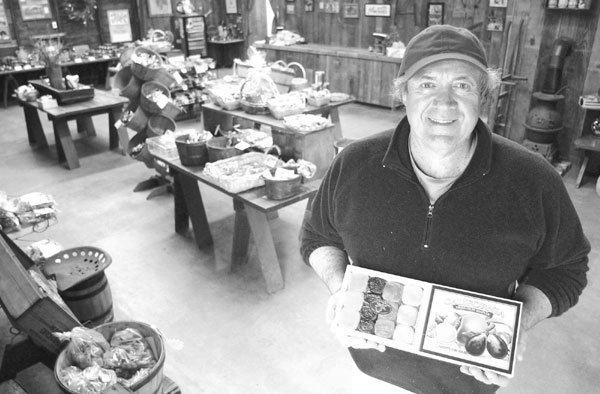Andy Mariani’s orchards are of another age, when Silicon Valley
was known as the Valley of the Heart’s Delight, before the fruit
basket of the world became ground zero in the high-tech
revolution.
Andy Mariani’s orchards are of another age, when Silicon Valley was known as the Valley of the Heart’s Delight, before the fruit basket of the world became ground zero in the high-tech revolution.
Mariani’s parents brought the family farming tradition to California from Italy. In 1957, his family moved from Cupertino to Morgan Hill and planted orchards of apricots and prunes. Cherries quickly followed. At that time, agriculture still had a future here. The corporate farmers in the Central Valley hadn’t completely asserted their dominance over the freeholding dirt farmers of South County. Mariani’s parents were just farmers; by his own admission, Andy Mariani is a relic, an economic dinosaur.
“Urbanization is on an inexorable march through the countryside, transferring rural use to urban uses.” he said recently, “The mix is inherently incompatible and not sustainable in the long run. Eventually I’ll be landlocked.”
Already he’s fenced in by a hospital, school and Highway 101, and to the north, the urban edge creeps ever closer to his land, the rooftops of new housing developments increasingly visible from Mariani’s fields.
Urbanization may be ruining small farming, but for Mariani and the rest of the region’s agricultural artifacts, it’s their key to survival, a market for those farmers able to forget about the middle man and bring their products directly to consumers.
For those willing to find it, the market is there, said Peggy Miars, president of California Certified Organic Growers in Santa Cruz. A lot of people who don’t know the difference between a Dolly plum and an October Sun, or a Dapple Dandy and a Flavor Grenade, are ripe for a new trend.
“Consumers are interested in learning more about farming,” Miars said. Back in the 1800’s people grew their own food and raised their own livestock, but now it’s a total mystery. People, especially from the city, don’t have a clue how a carrot is grown. It’s amazing how excited people get when they can actually pull one out of the ground themselves. It’s a very fun experience for them.”
But how do you get people to make a day trip to the farms and orchards of Morgan Hill, Gilroy and San Benito County just to buy a few cherries, apples or apricots?
“It’s been years since you could just pick your fruit, put it on a truck and send it to a distant market, especially in an urban environment,” Mariani said. “We have to look at more innovative ways of marketing. I’m taking a page out of the winery PR manual. Wine is just fermented fruit. We’re selling fruit that hasn’t been fermented. It’s a lot fresher and suitable for the whole family.”
The success of most small wineries has been in vintners’ ability to cultivate markets for varietals. You’ll never seen a wine section split into generic sections of “red” and “white,” but despite a dizzying array of fruit varieties, it’s the rare supermarket that makes an effort to differentiate between different types of fruit. Mariani grows 40 kinds of cherries, 20 types of apricots, more than 40 varieties of American and European Plums, all with distinct flavors, textures and growing seasons.
When he took over the orchards from his brother last year, Mariani opened a gourmet shop featuring preserves and chocolates with his dried apricots. He started holding fruit tastings, similar to wine tastings, he said, “but a lot less pretentious.” This year, he plans to hold tours and harvest walk to let people pick their own fruit.
“We haven’t fully implemented our business model yet,” he said. “But it won’t be a dog and pony show. We’re not going to have pit spitting contests and that kind of thing. It’s more subtle and adult oriented. We want to find the right strategy to get profit commensurate with the quality of our fruit.”
For now, most of Mariani’s fruit is sent off to packers and shipped to Japan, but he would like to sell more locally. He’s hampered by his location. In fact, it was only by chance that Jim and Debbie Hoey, the proprietors of Hoey Ranch on Hecker Pass, met Mariani in his shop late last summer and offered him what could turn out to be a big break.
The Hoey ranch, about a mile west of Santa Teresa Boulevard, has been in the family for five generations. Over the years the ranch has been a vineyard, a pear orchard and a tobacco farm. Until five years ago, the ranch was a pumpkin patch and a Christmas tree farm, but maintaining an ag enterprise was too much for the family. Debbie Hoey said all that time they were looking to bring someone in to preserve the tradition of the land. Before they came across Andy’s Orchard last summer, the Hoeys didn’t know it was there.
“Andy has such a great idea, but he’s not in the best location for a real good tourist draw,” Hoey said. “We’ve always wanted to have something back there farming-related, and we thought it would be so cool to have him grow some of his orchard back where we are. We want someone out there who can not just have a viable business but will carry on the tradition of farming in the family.”
Mariani hopes to have a gourmet shop at the ranch this year, and to harvest orchards there in summer of 2006. For those farmers not so fortunate to have prime tourist land offered to them, there are alternatives.
Todd Kennedy, an agriculture attorney in San Francisco who used to have orchards with 2,500 varieties of fruit in San Martin, said that the traditional model of 10 acres and a man and a horse doesn’t apply anymore. The only way to survive in this economy is to differentiate your farm from your neighbors’.
“Most people who are serious about farming are doing one thing or another to give people a reason to come to them,” Kennedy said. “They have to find niche markets as far as product or location in order to survive.”
Some urban-edge farmers have tried to cultivate relationships with chefs at gourmet restaurants. Kennedy said that San Jose is not a good bet for that approach, and even in a culinary paradise like San Francisco, he said, the restaurant relationship can be more a like a devil’s bargain for the farmer, who ends up ceding control of his operation to please one cook.
Kennedy said family farms are best suited to the region’s multitude of certified farmer’s markets, where growers can get their fruits and vegetables in the hands of a lot of consumers and try to build customer loyalty. Mari Rossi, of B&R Farm in Hollister, said that her family has traveled to markets as far afield as Los Altos and Santa Barbara.
B&R Farm has been in Hollister since 1929. Back then the farm was strictly an orchard growing walnuts, prunes and apricots. Now the Rossi family grows a lot of row crops – tomatoes, bell peppers, red onions – that it ships off to canneries. Like Mariani, the Rossi family is one of few that still grow the vanishing Blenheim apricot, a gourmet variety that dries well. At one time, the Blenheim apricot was king and San Benito County was it’s throne, before foreign apricots grown from Turkey flooded the markets.
Like Andy’s Orchards, B&R Farm features a gourmet shop that sells preserves and chocolates featuring the dried apricots, and they have a mail-order business. The Rossis also sell the apricots to restaurants and wholesalers and at farmers’ markets.
“We have a unique enterprise,” Mari Rossi said recently. “We’re trying to keep our small business afloat with mail-order, but times have changed and just keeping the farm running is a hard task in itself.”
Rossi said her family has experimented in cooperative ventures in the past, but does so as a last resort, typically when a particular year’s crop isn’t very strong.
“You always want to sell your product first, but if we can work something out with other growers, we’re open to that, too,” Rossi said. “It depends on the quality of the fruit and the season, and what nature brings. This last season the fruit was gorgeous and that hasn’t happened in many years.”
Russ Bonino of LBJ Farms in Gilroy said the pressures to stay competitive are taking a toll on the land, making it even more difficult to get consistent high-quality crops, especially for farmers with three-month growing seasons.
“The general public doesn’t understand how much the weather affects us,” Bonino said. “The playing field is not level here, and that’s where we run into problems. We have to double and triple-crop. Our ground is tired; it’s been intensively cultivated for more than a hundred years.”
The Bonino family has farmed the land at Fitzgerald and Monterey on the Gilroy-San Martin border for four generations. Bonino jokes about selling out, but said “it’s tough to say whether we would, we’ve been here since 1917.”
Grass Farm’s Garden Accents, with sites in Morgan Hill and on the Gilroy-San Martin border, is determined to stay in business. The Gil family used to sell only sod. Now they sell pottery, fountains and statuary, and they’re moving into the nursery business. Erin Gil, production manager for the operation owned by his family since 1969, said that Garden Accents is trying to set itself up to not rely on one single product for its survival.
“Since we’re in the landscape business, we’re trying to diversify and have more lines for people to decorate their homes and gardens,” Gil said. “So far it’s cost a lot of money but we think it’s an investment and we’ve never had so many compliments.”
Garden Accents is also offering finer-bladed and drought-tolerant sod – called a tall fescue – that resembles Kentucky blue grass, something Gil called a “big gain for the turf industry,” and a line of specialty products like weeping cherries and topiaries.
“What we’re most excited about is that we’re bringing in a lot of things you can’t find at local nurseries,” he said. Garden Accents also offers a number of educational programs for their customers and prospective customers. Gil said it’s hard to know how much business the classes bring Garden Accents, but that they’re worth it to build goodwill and knowledgeable customers.
“It’s intangible,” Gil said. “I think the growers in South County who can be successful today are those who can produce a product and get it to the marketplace. In terms of our customer services, we try to provide clients with all the information we can to make the right choices about what to plant and how to plant it to make it water conserving and improve the value of their homes.”
Many growers in the region try to bring tourists and business to their farms with the Country Crossroads Farmers to You map, a long-time collaborative effort of farmers in Santa Clara and Santa Cruz Counties. The 30th edition, scheduled for an April release, will be the first time it also features farmers in San Benito and Monterey counties.
“It’s a great tool to educate the non-farming public about where farms are and what you can get there,” said Jenny Derry, executive director of the Santa Clara County Farm Bureau. “There’s a lot of people in the Bay Area interested in coming down here and going from farm to farm to see how food is grown.”
The Crossroads map shows the location of all the farmers who participate, a harvest calendar and a guide to finding particular fruits and vegetables. Every year, about 60,000 copies are distributed to hotels and tourist bureaus, and at events like those celebrating Earth Day and Arbor Day. Derry said the maps are good resource for attracting children, especially home-schooled children.
“This is something that’s really big in Europe, visiting farms as a form of tourism,” she said. “I think it’s going to grow here and we want to be on the edge of that.”
Mariani and his colleagues are counting on turning neighbors into tourists and tourists into customers, but no one farming in this region is getting rich on daytrippers yet. For Mariani, it’s about the fruit, and his connection to his family’s tradition and the orchards that used to blanket the valley.
“I couldn’t be a broccoli or wheat farmer,” he said. “There’s a certain romance to fruit. Maybe if I grew up in Salinas growing broccoli I would see the romance in it, but I grew up in this area and I feel like I’m part of the tradition and history of growing fruit. Even if I had all the money in the world, my avocation would be growing fruit. When I retire, I’m still going to grow fruit.”
Local agriculture sites
These are some of the interesting agriculture sites in Santa Clara and San Benito counties. be sure to call ahead to confirm harvest times.
Andy’s orchard
1615 Half Rd.
Morgan Hill
792-7600
andysorchard.com
LJB Farms
585 Fitzgerald Ave.
San Martin
842-9755
B&R Farms
5280 Fairview Rd.
Hollister
831-637-9168
b&rfarm.com
Van Dyke Ranch
7665 Crews Rd.
Gilroy
842-5423
831-475-7665
www.localharvest.org
Grass farm’s
garden accents
11155 Lena Ave.
Gilroy
846-4555
www.grassfarm.com














